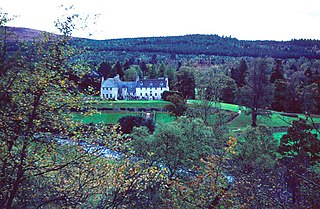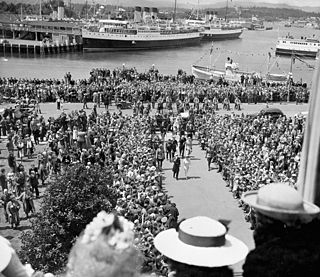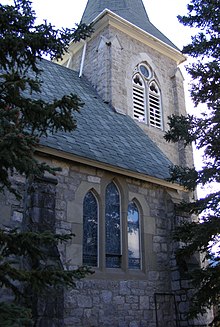History
The first Anglican service in Banff took place in a log cabin on Bear Street in 1887 before holding worship in a tent on the site of the present-day church as it was being built. Clergy also led evening service at the Banff Springs Hotel. The chancel was complete by 1897 [1] and the Bishop of Calgary, the Right Reverend William Pinkham, consecrated St George's in June 1920, [3] before the tower and spire were finished in 1926. [1]
Prince George, Duke of Cornwall and York (laterly King George V), and his wife, Princess Mary, Duchess of Cornwall and York (the future Queen Mary), worshipped at St George-in-the-Pines in 1901. Three of their sons attended service at the church: Prince Edward, Prince of Wales (the future King Edward VIII), together with Prince George in 1927, [1] and King George VI with his consort, Queen Elizabeth, in 1939. The pew in which the latter two sat is marked with a plaque. [2] George and Elizabeth's daughter, Elizabeth II, the former Queen of Canada, also worshipped at St George-in-the-Pines. [4]
In 2012, the church sought designation as a municipal historic resource and received approval on 30 July of the same year. [1] [4] It was also included as a point of interest along the Commonwealth Walkway, which was opened on 17 September 2017. [5]

George VI was King of the United Kingdom and the Dominions of the British Commonwealth from 11 December 1936 until his death on 6 February 1952. He was also the last Emperor of India from 1936 until the British Raj was dissolved in August 1947, and the first Head of the Commonwealth following the London Declaration of 1949.

Charles III is King of the United Kingdom and the 14 other Commonwealth realms.
The style and title of the Canadian sovereign is the formal mode of address of the monarch of Canada. The form is based on those that were inherited from the United Kingdom and France, used in the colonies to refer to the reigning monarch in Europe. As various Canadian territories changed ownership and then the country gradually gained independence, the style and title of the monarchs changed almost as often as the kings and queens themselves. The mode of address currently employed is a combination of a style that originates in the early 17th century and a title established by Canadian law in 1953.

The Head of the Commonwealth is the ceremonial leader who symbolises "the free association of independent member nations" of the Commonwealth of Nations, an intergovernmental organisation that currently comprises 56 sovereign states. There is no set term of office or term limit and the role itself has no constitutional relevance to any of the member states within the Commonwealth. The position is currently held by King Charles III.

Crathie Kirk is a small Church of Scotland parish church in the Scottish village of Crathie, best known for being the regular place of worship of the British royal family when they are in residence at the nearby Balmoral Castle.

Birkhall is a 210 km2 estate on Royal Deeside, Aberdeenshire, Scotland, owned by King Charles III. It is located alongside the River Muick to the south-west of Ballater.

The monarchy of Australia is Australia's form of government, embodied by the Australian sovereign and head of state. The Australian monarchy is a constitutional one, modelled on the Westminster system of parliamentary government, while incorporating features unique to the constitution of Australia.

The Cave and Basin National Historic Site of Canada is located in the town of Banff, Alberta, within the Canadian Rocky Mountains, at the site of natural thermal mineral springs around which Canada's first national park, Banff National Park, was established.

By the arrangements of the Canadian federation, the Canadian monarchy operates in Newfoundland and Labrador as the core of the province's Westminster-style parliamentary democracy. As such, the Crown within Newfoundland and Labrador's jurisdiction is referred to as the Crown in Right of Newfoundland and Labrador, His Majesty in Right of Newfoundland and Labrador, or the King in Right of Newfoundland and Labrador. The Constitution Act, 1867, however, leaves many royal duties in the province specifically assigned to the sovereign's viceroy, the lieutenant governor of Newfoundland and Labrador, whose direct participation in governance is limited by the conventional stipulations of constitutional monarchy.

By the arrangements of the Canadian federation, Canada's monarchy operates in Alberta as the core of the province's Westminster-style parliamentary democracy. As such, the Crown within Alberta's jurisdiction is referred to as the Crown in Right of Alberta, His Majesty in Right of Alberta, or The King in Right of Alberta. The Constitution Act, 1867, however, leaves many royal duties in Alberta specifically assigned to the sovereign's viceroy, the Lieutenant Governor of Alberta, whose direct participation in governance is limited by the conventional stipulations of constitutional monarchy.

St George's Church, Esher is a Grade I listed Anglican church in Esher, Surrey, England. Built in the 16th century, it was Esher's parish church for 300 years, though later worshippers included Queen Victoria. However, by the mid-19th century the building was deemed too small for the growing population, and was replaced by Christ Church, built nearby on Esher Green in 1853/4. St George's was not therefore subjected to Victorian ‘improvements’, and its Tudor origins remain evident. It is now cared for by the Churches Conservation Trust.

Elizabeth II was Queen of the United Kingdom and other Commonwealth realms from 6 February 1952 until her death in 2022. She was queen regnant of 32 sovereign states over the course of her lifetime and remained the monarch of 15 realms by the time of her death. Her reign of over 70 years is the longest of any British monarch and the longest verified reign of any female head of state in history.

St George's Chapel at Windsor Castle in England is a castle chapel built in the late-medieval Perpendicular Gothic style. It is a Royal Peculiar, and the Chapel of the Order of the Garter. St George's Chapel was founded in the 14th century by King Edward III and extensively enlarged in the late 15th century. It is located in the Lower Ward of the castle.

The coronation of Elizabeth II as queen of the United Kingdom and the other Commonwealth realms took place on 2 June 1953 at Westminster Abbey in London. She acceded to the throne at the age of 25 upon the death of her father, George VI, on 6 February 1952, being proclaimed queen by her privy and executive councils shortly afterwards. The coronation was held more than one year later because of the tradition of allowing an appropriate length of time to pass after a monarch dies. It also gave the planning committees adequate time to make preparations for the ceremony. During the service, Elizabeth took an oath, was anointed with holy oil, was invested with robes and regalia, and was crowned Queen of the United Kingdom, Canada, Australia, New Zealand, South Africa, Pakistan, and Ceylon.

Royal tours of Canada by the Canadian royal family have been taking place since 1786—when the future King William IV became the first member of the royal family to visit Canada—and continue into the 21st century, either as an official tour, a working tour, a vacation, or a period of military service by a member of the royal family. In 1939, King George VI became the first reigning monarch to tour the country.

The 1939 royal tour of Canada by King George VI and Queen Elizabeth was undertaken in the build-up to the Second World War as a way to shore up sympathy for Britain, should war break out in Europe. The tour lasted from 17 May to 15 June, covering every province, the Dominion of Newfoundland, and a few days in the United States. It demonstrated and cemented Canada's allegiance to the Crown and its status as the senior Dominion of the British Empire. There had been previous royal tours in Canada, but, the 1939 tour was unprecedented, both due to the fact that it was the first visit to North America by the reigning monarch, as well as in its scope. The tour was an enormous event, attracting huge crowds at each new city.

On 8 September 2022, at 15:10 BST, Elizabeth II, Queen of the United Kingdom and the other Commonwealth realms, and the longest-reigning British monarch, died at Balmoral Castle in Aberdeenshire, Scotland, at the age of 96. Her death was publicly announced at 18:30. She was succeeded by her eldest son, Charles III.

















